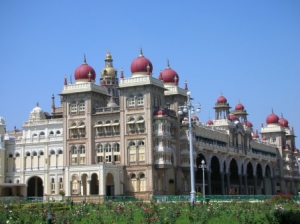 MYSORE CAPITAL OF THE WODEYAR
MYSORE CAPITAL OF THE WODEYAR
Mysore was the ancient capital of the Wodeyar rulers. The current city is the creation of Tipu Sultan who levelled the old city and built this new one. It has a pleasant climate with sprawling gardens, tree-lined boulevards and relaxed pace of life, making it one of the most attractive south Indian cities. It is a major cultural centre and also important for sandalwood carving, incense and silk production.
It is a compact city with many of the tourist attractions within strolling distance. Bangalore is only 3 hours drive away and Mysore is well connected to all major towns in Karnataka, the spice hills of Wayanad and the scenic coffee plantations of Coorg.
The city celebrates the 10 day Dasara Festival in September/ October (known as Dussehra in north India.) It is a lively event with bands, concerts and parades. On the last evening there is a torchlight parade by the mounted guard and festivities culminate in a firework display. All the public buildings are lit by fairylights. It is worth seeing, although the city does get very crowded. Visit the Sandalwood Oil Factory (on request) or Silk Factory to get an authentic experience.
PLACES OF INTEREST:
AMBA VILAS PALACE
The British designed Mysore Palace is a magnificent palace incorporating onion domes, cupolas, turrets and minarets and the extravagant Durbar Hall features Bohemian chandeliers, Belgian stained glass, pietra dura on the floors and cast iron pillars from Glasgow. It takes about two hours to see everything but go in the morning to avoid crowds. Cameras and shoes are not allowed, but free lockers are provided. Try to see it on Sunday night when 90,000 light bulbs bring it to life.
DEVARAJA MARKET
This famous market is packed with stalls selling everything from marigolds and jasmine, bananas, juicy mangoes, religious items and household goods to conical piles of colourful kumkum powder. A riot of colour and definitely NOT to be missed.
CHAMUNDI HILL
Terrific views of the city as you are driven up, equally beautiful by night as the city lights twinkle below. At the top is Chamundeshwari Temple which is open to non Hindus. On the way down there is a magnificent 16 ft. granite monolithic sculpture of Nandi the bull. It is usually garlanded with flowers and bells and there are other smaller shrines on the way down. There are about 1000 steps to get to the bottom. Take water and don’t attempt in the heat of the day! Tuesdays and Fridays are auspicious days and tend to be busier. Leave shoes outside.
MYSORE ZOO
Established in 19th century, it is one of the best zoos in India.
SRIRANGAPATTANA
10 miles north of Mysore is this island fortress in the middle of the Kaveri River. It was built in 1454 and in the latter part of the 18th century became the capital of Haidar Ali . His son Tipu Sultan used it as his headquarters against the British and it was here that he was killed. The Daria Daulat Bagh is Tipu Sultan’s beautiful summer palace and Gumbaz is the family mausoleum and are both worth visiting. Coracles are available for hire to take a ride across the river.
BRINDAVAN GARDENS AND KRISHNA RAJA SAGAR DAM
Situated about 12 miles north of Mysore is one of India’s largest dams. Extending from the side of it is a vast terraced garden. These lovely ornamental gardens are beautifully maintained and have fragrant flowers and paths for peaceful walks. At night the fountains are flood lit by thousands of coloured fairy lights and spout water to Indian pop music. Indian kitsch at its most enjoyable! About a 30 minute drive.
RANGANATHITTU BIRD SANCTUARY
10 miles from city, this lovely sanctuary of tiny islands and rocks nestles between rice paddies. The best way to see the water birds is by boat which can also get you up close to crocodiles too.
SOMNATHPUR
Situated 22 miles from city it is one of the finest examples of Hoysala architecture. The Keshava Vishnu Temple was built in 1268 and since it was the last one built it is rather better preserved than Halebid or Belur since it has complete towers. About 90 minute drive from Mysore.
SRAVANA BELGOLA, HALEBID AND BELUR
120 miles northwest of Mysore lie three important sites.
Sravana Belgola town sits between two hills. On top of one sits the colossal monolithic statue of the Jain saint Gomateshwara carved in 981AD and it may be the largest monolithic statue in the world. Naked, 58 ft. high, 26ft. wide shoulders and 10ft. feet it towers above the valley. It is the most important Jain site in south India and is reached by 614 steps cut into the mountain. Climb it before dawn to watch the sunrise over the sugar cane fields for an unforgettable memory. Shoes must be removed and bags left at the site office. Take plenty of water.are two remote temple sites which were once flourishing cities in the 12th century Hoysala Dynasty. They lie about 3 hours from Mysore.
Best explored by a guide, shoes need to be removed before entering the temples so bring socks since the ground can get very hot, especially at Belur. A torch would also be handy to fully appreciate the intricate sculptures inside.The Chennakeshava Temple at Belur is still used to worship a Vishnu incarnate so although non Hindus cannot enter the inner sanctum if you time it properly it is possible to see inside when it is open.
At Halebid, the Hoysaleswara Temple is dedicated to Shiva and has some breathtaking friezes around the temple walls.







